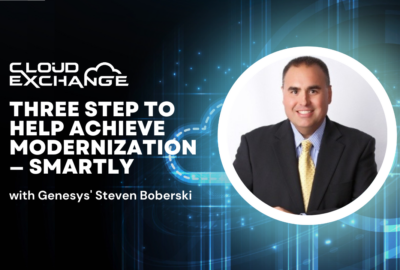Insight by Genesys
Cloud Exchange 2024: Reimagining customer experience through ‘actionable intelligence’
Genesys' U.S. public sector vice president offers actionable insights on improving CX through agent assist technology and cloud.
Stress is too often present in customer experience encounters, on both the side of the customer and the employee.
Part of this is that customer expectations are dramatically higher in recent years. Citizens have become used to the kinds of experiences they have on their cell phones, from online shopping to apps. But government agencies struggle to provide that same kind of experience, for a host of reasons.
“There are many things that make customer experience a tricky category. It isn’t easy to meet those needs and those expectations,” said Jason Schick, U.S. public sector vice president for Genesys. “Different customers want to communicate differently, but they expect the same satisfying outcomes, whether they interact by phone call, email, SMS text, social media or chatbots. Getting consistency and uniformity of information and outcome across channels takes a lot of coordination.”
Agencies have to figure out answers to difficult questions, Schick said during Federal News Network’s Cloud Exchange 2024. He offered a few examples:
- How do you get an agent involved at the right time, before the customer gets stuck?
- How do you determine the agent best suited to resolve the issue?
- How can that agent be aware of the context without requiring the customer to repeat themselves?
Then, there’s the issue of employee morale, which is a struggle most call centers face and leads to the dual challenges of low retention and large investments in hiring and training that take time to pay off, Schick said.
How agencies can improve CX
Improving CX is a governmentwide goal, and every public facing agency wants to help its employees who interact directly with citizens do so better and accomplish more in those interactions. One way Schick suggested that agencies can do this is with agent assist technology.
For example, working with the National Domestic Violence Hotline, Genesys was able to help implement an artificial intelligence-driven system that makes inferences about the caller — whether they’re using voice, text or chat channels — to help route them to the right agents and provide additional context for that agent. That helps the hotline bring the best possible capabilities to bear in support of callers in their moments of crisis.
“It’s about deriving intelligence that becomes actionable in the moment,” Schick said. “CX is becoming increasingly data-centric. There are large, important repositories of information across large enterprises that include lots of biographic data, lots of historical data about every individual customer. We’re going to see the history and all the characteristics of the person who’s calling start to show up in the services provided by the agents and by all the bots. That shows an even greater understanding of who they are and what they’ve done before and therefore predicts what they might need.”
Importance of cloud to future of CX
Many of these advances are made possible by the maturation of the cloud. Dynamic scaling and automatic fail-over are helping agencies deal with fluctuations in volume, which is especially important to agencies like the IRS, which have predictable, seasonal influxes, or the Federal Emergency Management Agency, which has spikes that follow major natural disasters. It also allows agencies to scale their workforce more quickly by enabling employees to work remotely.
Cloud is also a necessary prerequisite for AI. Cloud scaling is required for the kind of data collection and analysis required to train these algorithms, as well as the processing power necessary to operate them.
“We’re at the early stages of a major reimagination of what experience is for customers and for government,” Schick said.
Where agencies can begin on CX improvement
For agencies looking at where to begin their efforts in improving CX, Schick has some advice: Start with experience orchestration. Agencies can map out customer interaction journeys and identify the points of friction. There are usually easily identifiable interactions where customers get stuck, lost or frustrated. And often, these will align with areas of stress for employees as well. Schick said application of AI or automation at these friction points will smooth the interaction, improve the resolution path and build confidence with customers.
From the opposite perspective, agencies can also integrate existing systems and user interfaces to improve the employee experience. Reducing or eliminating the “swivel chair” dynamic — where employees have to pivot between systems, including reentering data manually — can allow them to focus on serving customers more effectively and efficiently, improving the customer experience.
“The experiences of the customer and of the call center agent are so deeply intertwined. At Genesys, we exist to make big improvements for both,” Schick said. “Genesys is highly focused on using the latest technology to bring empathy to each touch for the customer and the employee. Because we believe deeply that by doing so, we power the kind of experiences that breed satisfaction, loyalty and confidence.”
Discover more articles and videos now on Federal News Network’s Cloud Exchange 2024 event page.
Copyright © 2025 Federal News Network. All rights reserved. This website is not intended for users located within the European Economic Area.





